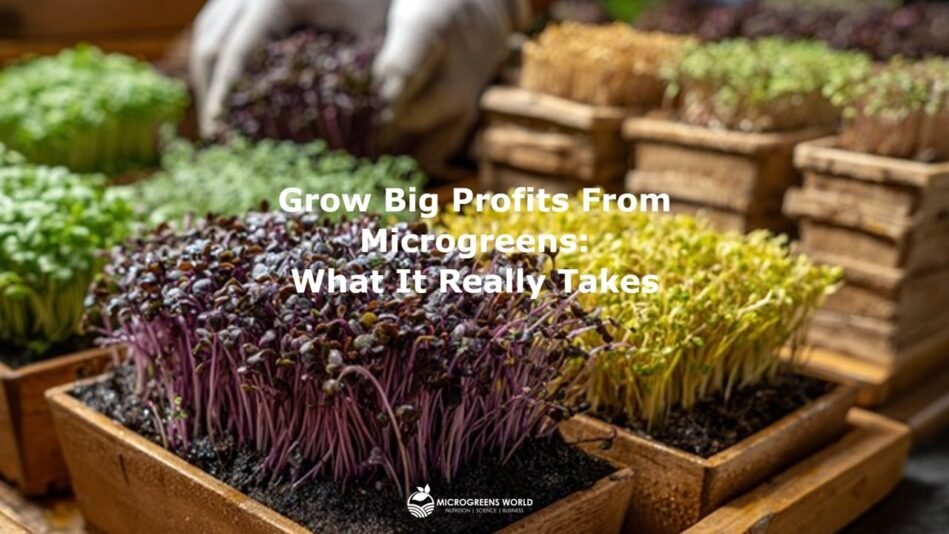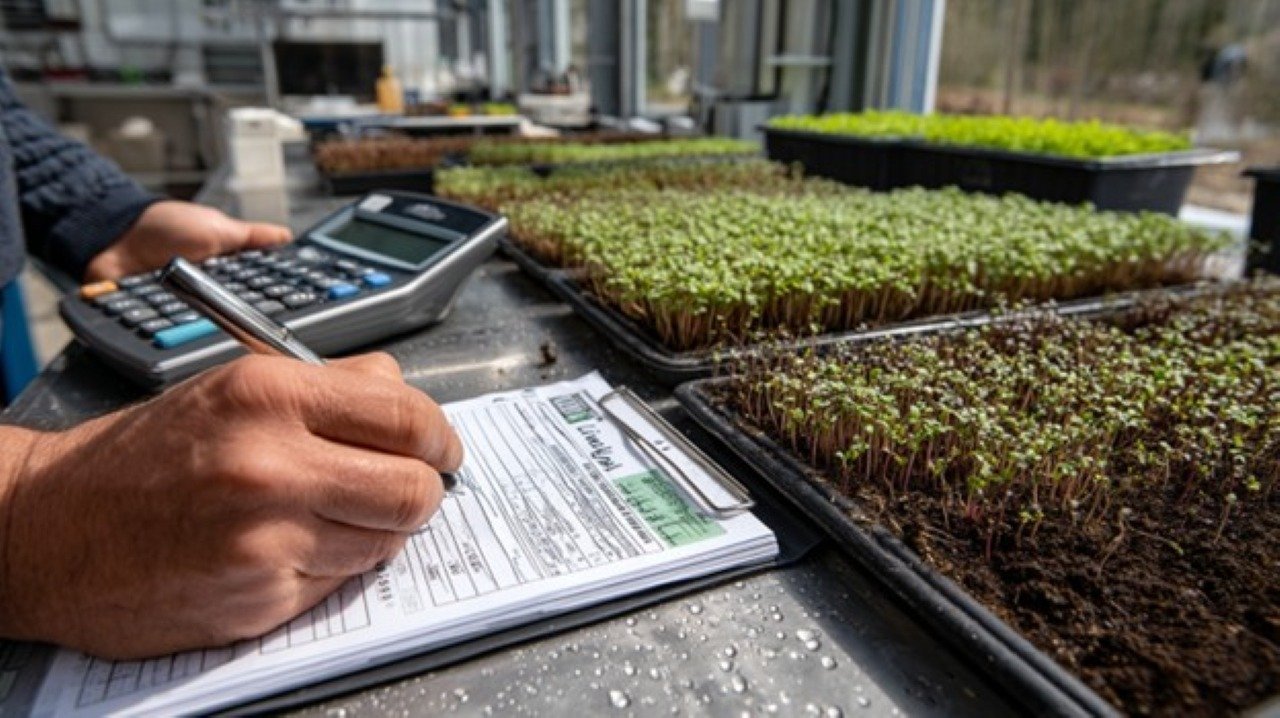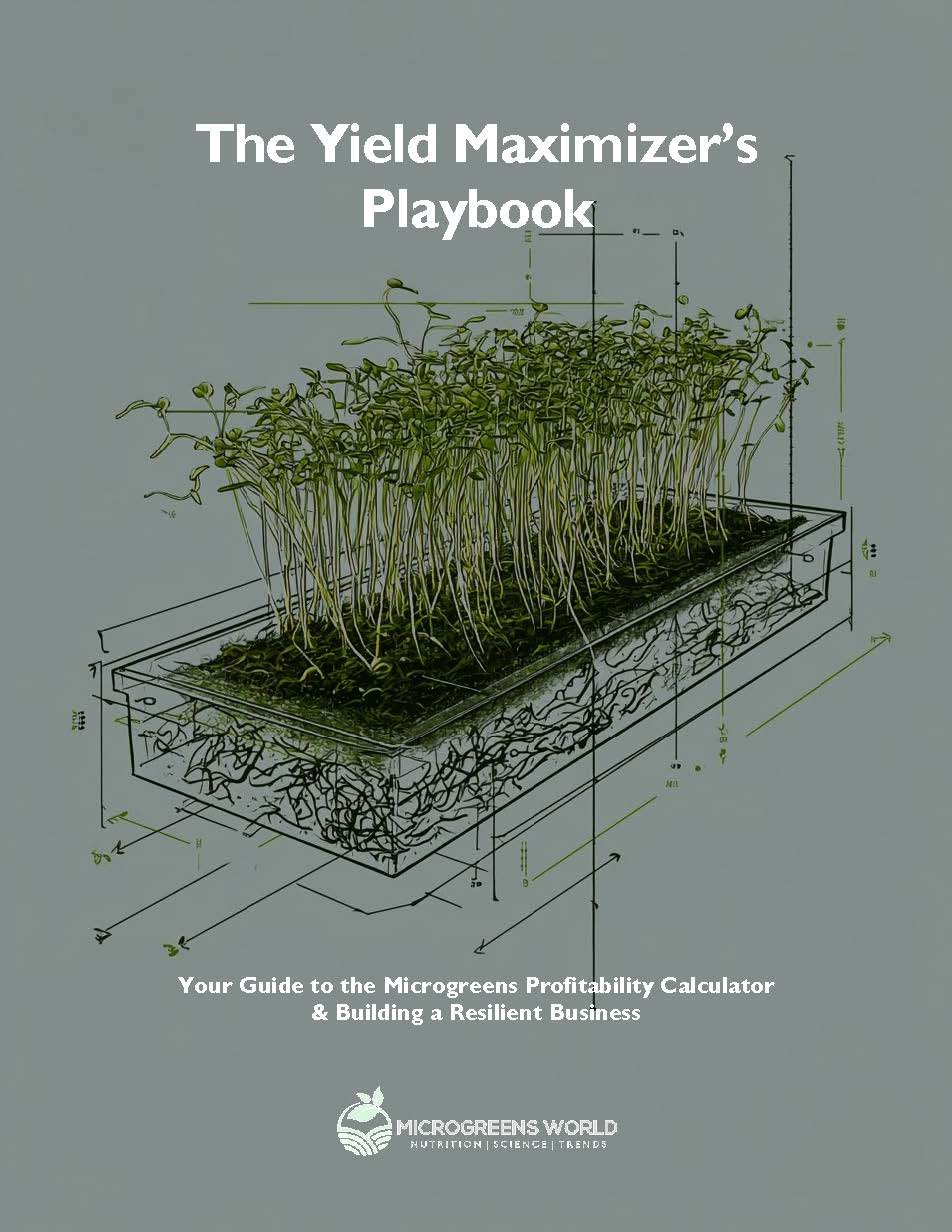I have gotten this question hundreds of times from community members: “How much does it cost to start a microgreens business?”
Microgreens startup costs range from $500-$1,000 for basic home operations (requiring LED grow lights at $30-100, 10-20 trays, seeds for 10-15 varieties, and growing medium) to $5,000-$10,000 for commercial ventures. With 7-14-day harvest cycles yielding $15-30 in profit per tray and seeds as the primary recurring expense, microgreens deliver faster cash flow than traditional agriculture.
You can grow substantial profits from microgreens with relatively low startup costs—as little as $500-$1,000 for a basic home setup.
Your biggest expenses will include shelving, grow lights ($20-100), seeds (your largest recurring cost), growing medium, and trays.
Start small with a few varieties, test market demand, and gradually scale based on customer response.
Managing costs through DIY solutions and energy-efficient practices helps maximize your margins while building a sustainable business that thrives in minimal space.
In this post, you get the answer to startup costs, operating costs, and some not-so-obvious and hidden costs.
Read on.
Key Takeaways
- Start with just $500-$1,000 for a home-based setup and gradually scale based on customer demand.
- Focus on high-yield microgreen varieties with premium pricing potential to maximize profit margins.
- Reduce ongoing costs by optimizing seed purchases, energy-efficient lighting, and sustainable growing media.
- Create professional branding and packaging that appeals to high-paying restaurant clients and health-conscious consumers.
- Develop efficient growing systems with staggered planting schedules to ensure consistent weekly harvests and revenue.
Are You Ready to Start Your
Microgreens Business?
Take a 5-minute assessment and discover your strengths and gaps
before you invest
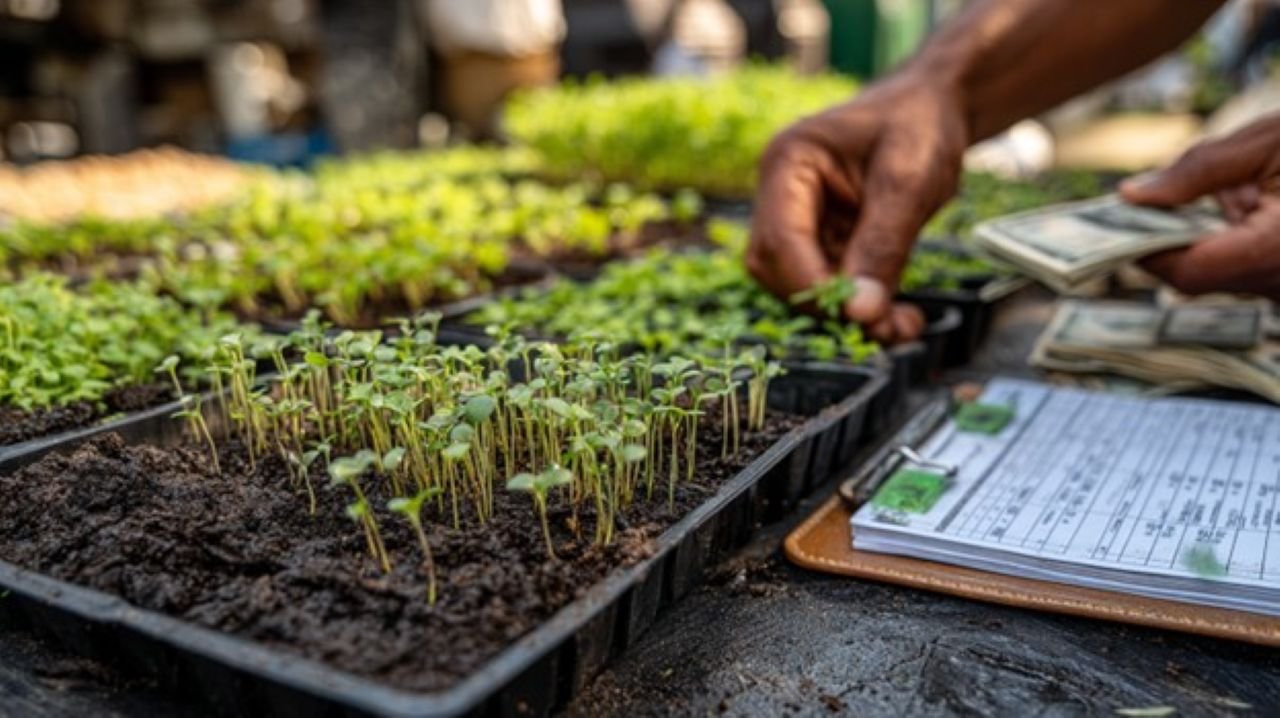
You’ll find microgreens startups fall into three main investment categories, starting with the budget-friendly $500-$1,000 range for a home-based operation.
If you’re looking for more professional equipment and presentation, the mid-range option at $2,000-$5,000 provides sturdy shelving, better lighting, and improved packaging.
Commercial ventures typically require $5,000-$10,000—covering multiple growing racks, climate control systems, and proper marketing materials to position your tiny greens for maximum profit.
Low-End Startup: $500-$1,000
You’ll be surprised how little you need to launch your microgreens venture, with most budget setups requiring just $500-$1,000 for the essentials.
This starter investment covers your basic infrastructure—used shelving (or something you build yourself), a few quality grow lights, and 10-20 growing trays—plus the raw materials like soil or coco coir and a diverse selection of 10-15 seed varieties.
While it’s not fancy, this modest setup transforms a spare room, basement, or garage into a functional growing space that lets you explore both your techniques and the market before scaling up.
Basic shelving (used or DIY)
Shelving serves as the backbone of any microgreens operation, providing the essential framework for maximizing vertical growing space without breaking the bank.
You’ll find incredible value in repurposed wire shelving units from restaurant supply stores or secondhand marketplaces. Consider materials like steel or aluminum that won’t rust with repeated watering—they’re worth the investment.
For true budget DIY setups, try cinder blocks and wooden planks that you can reconfigure as your operation grows.
A few grow lights
Three to four grow lights constitute the most critical investment for your low-budget microgreens startup, as proper lighting directly impacts yield quality and growth rates. You’ll find LED options offer the best balance of affordability and efficiency—they’ll pay for themselves through lower electricity bills while providing the right light spectrum for healthy growth.
| Light Type | Approximate Cost | Energy Efficiency |
| T5 Fluorescent | $20-45 per fixture | Moderate |
| LED Panels | $30-80 per unit | High |
| Full Spectrum LEDs | $50-100 per unit | Very High |
Seeds (10-15 varieties)
Seeds represent the foundation of your microgreens enterprise, with a starter collection of 10-15 varieties costing between $75-150 for your initial investment.
Focus on high yield varieties like sunflower, pea shoots, and radish to maximize your returns.
You’ll want to investigate organic seed options and develop smart seed sourcing strategies—buying in bulk when possible while ensuring you’re getting quality seeds that’ll produce consistent results.
Growing medium (soil or coco coir)
Choosing the right growing medium forms a critical foundation for your microgreens operation, with soil and coco coir representing the two primary options at the budget level. Each offers distinct advantages for your startup.
| Medium | Cost | Soil Benefits | Nutrient Retention | Reusability |
| Soil | $15-25/bag | Complete nutrient profile | High natural capacity | Limited |
| Coco Coir | $20-30/block | Excellent drainage | Needs amendments | Multiple cycles |
Basic trays (10-20 to start)
Investing in the right growing trays forms the backbone of your microgreens operation, with even a modest startup requiring 10-20 trays to establish a production cycle.
Standard 10″x20″ plastic trays are most common, with options in both reusable (polypropylene) and biodegradable materials.
You’ll need two types: solid-bottom trays for catching water and perforated trays for drainage—the perfect combo for healthy roots and sturdy seedlings.
Simple packaging supplies
Your packaging options at the low-end startup level don’t need to be elaborate, yet they still represent an essential cost component in your microgreens business.
Consider basic packaging materials like plastic clamshells ($20-30 per 100), compostable containers, or simple zip-top bags with custom labels.
Eco-friendly options might cost slightly more but can strengthen your branding strategies—customers often appreciate sustainable packaging that matches your fresh, healthy product.
Business registration fees
Business registration fees represent the official gateway to legitimacy for your microgreens venture, typically ranging from $50-$200 depending on your location and business structure.
You’ll need to complete the registration process overview with your local government, which often includes obtaining a business license, tax ID, and possibly food handling permits—essential paperwork that, while tedious, protects you legally as fee variations explained differ by municipality.
Mid-Range Startup: $2,000-$5,000
Stepping up from bare-bones to mid-range investment ($2,000-$5,000) gives you room to think bigger about your microgreens operation.
You’ll need to upgrade your equipment with sturdy metal shelving units, high-quality LED grow lights that won’t fail mid-growth, and basic climate control tools like fans and dehumidifiers to create ideal growing conditions.
This investment level also allows you to expand your seed inventory beyond the basics and create professional packaging that catches customers’ eyes at farmers’ markets and on store shelves.
Sturdy metal shelving units
Investing in quality metal shelving represents the backbone of your microgreens operation—literally supporting your entire growing system while withstanding the weight of water-laden trays and equipment.
You’ll want shelves rated for at least 300-500 pounds per tier for optimal shelf durability.
When planning your setup costs, consider that adjustable units allow for space optimization as you experiment with different tray arrangements and growing heights.
Higher quality LED grow lights
While basic fluorescent lighting might function for hobbyists, proper LED grow lights become a critical investment at the mid-range startup level—typically accounting for $500-1,000 of your budget.
You’ll want to choose options that balance energy efficiency with growth performance—LEDs consume up to 60% less electricity than traditional lighting while promoting stronger, more vibrant microgreens that’ll fetch premium prices at market.
Climate control basics (fans, small dehumidifier)
A proper climate control system represents the difference between thriving crops and disaster in your microgreens operation.
You’ll need to invest in oscillating fans ($20-50 each) to prevent mold and strengthen stems, plus a small dehumidifier ($150-200) to maintain optimal humidity levels (50-60%).
These climate control strategies guarantee consistent temperature regulation (60-75°F), creating an environment where your tiny greens flourish year-round.
More diverse seed inventory
Expanding your seed inventory becomes essential as you scale from hobbyist to serious microgreens entrepreneur.
You’ll want to investigate diverse seed sourcing options—from specialty suppliers to organic wholesalers—to uncover which varieties yield the best returns.
Invest in nutrient-rich microgreens that customers crave, like spicy radish, earthy sunflower, and delicate amaranth.
Your microgreens variety selection directly impacts profitability and market differentiation.
Professional-looking packaging
Professional packaging elevates your microgreens from “backyard project” to “premium product” in customers’ eyes.
Invest in branded compostable containers that showcase your greens while reinforcing your branding strategies.
Consider clamshells that protect delicate shoots and create attractive displays.
Design tips: employ transparent lids, clean labels with your logo, and sustainable materials like corn-based plastics—customers increasingly expect environmental responsibility alongside quality.
Website setup
Your online presence serves as your 24/7 sales representative in today’s digital marketplace. You’ll need to allocate $300-$800 of your mid-range budget for a functional website that converts visitors into customers.
| Website Design Essentials | E-commerce Platforms |
| Mobile-responsive layout | Shopify ($29/month) |
| Product photography | WooCommerce (free + hosting) |
| Clear pricing structure | Square Online (0-2.9% fees) |
| About/Story page | Squarespace ($23/month) |
| Contact form | Local pickup options |
Basic marketing materials
The investment in marketing materials represents a modest but essential portion of your mid-range startup budget, typically running between $200-$500.
These materials should reflect your branding strategies while appealing to your target audience—chefs, health-conscious consumers, and local businesses.
You’ll need professional business cards, product labels, informational brochures, and a strategic social media presence that showcases your vibrant microgreens in action.
Commercial Startup: $5,000-$10,000
When you’re ready to scale up to a serious commercial operation, you’ll need to invest $5,000-$10,000 in essential infrastructure like multiple growing racks and a complete climate control system.
Your shopping list will also include professional packaging equipment, delivery vehicle expenses, and a dedicated marketing budget to attract restaurant clients and retail customers.
This level of investment transforms your microgreens hobby into a legitimate business that can generate substantial returns—potentially $20 per tray with 90% profit margins when you’re running at full capacity.
Multiple growing racks
Sturdy, commercial-grade growing racks represent the backbone of any serious microgreens operation, transforming your available vertical space into a productive growing environment.
You’ll need multiple racks to achieve commercial scaling—typically 4-6 tier systems that maximize your square footage while supporting efficient irrigation systems.
When selecting racks, prioritize those specifically designed for sustainable agriculture with adjustable shelving that can handle the weight of fully saturated growing trays.
Complete climate control system
Investing in a complete climate control system represents a critical turning point for commercial microgreens operations, transforming your growing space from a basic setup into a professional production facility.
You’ll need to implement temperature regulation techniques (65-75°F is ideal), humidity control methods (maintaining 40-60%), and optimal airflow strategies that prevent mold while strengthening stems.
These three elements work together to create consistent harvests year-round, regardless of external weather conditions.
Professional packaging equipment
Professional packaging equipment forms the cornerstone of your microgreens brand identity and product protection at the commercial level. You’ll need to invest in tools that preserve freshness while showcasing your branding strategy.
| Equipment Type | Purpose | Cost Range |
| Heat Sealer | Extends shelf life | $200-500 |
| Label Printer | Reinforces branding | $300-800 |
| Packaging Station | Improves workflow | $400-1200 |
Customer feedback consistently shows attractively packaged microgreens command premium prices—don’t skimp here.
Delivery vehicle expenses
Transportation costs represent a vital investment within your commercial microgreens startup budget.
You’ll need to consider different delivery vehicle types—from fuel-efficient compact cars to refrigerated vans—depending on your client distribution and volume. Smart transportation logistics planning can dramatically reduce your overhead; many successful growers start with personal vehicles before upgrading.
Effective cost management might include route optimization software and scheduled maintenance—expenses that quickly pay for themselves.
Marketing and advertising budget
Within a commercial microgreens operation, your marketing and advertising expenses will likely consume 10-15% of your initial $5,000-$10,000 startup budget. These funds should be strategically allocated to establish your brand identity and attract your first customers.
| Marketing Approach | Cost Range | Potential Impact |
| Social media strategies | $300-500 | Builds online presence, showcases product freshness |
| Local partnerships | $200-400 | Creates reliable revenue streams with restaurants and markets |
| Promotional events | $400-700 | Generates immediate sales and valuable customer feedback |
Insurance and licenses
Three essential legal protections often overlooked by new growers include proper insurance coverage and the necessary licenses to operate legitimately.
You’ll need liability insurance (protecting against customer claims), property coverage, and possibly crop insurance depending on your scale.
Don’t delay maneuvering through licensing processes—most municipalities require food handling permits and business licenses.
Proper risk management isn’t just legal compliance; it’s investment protection that prevents one mishap from destroying your budding microgreens empire.
Professional website and online ordering system
Beyond legal considerations, a professional website and online ordering system represent major components of your commercial microgreens operation.
Customers expect seamless e-commerce solutions that showcase your products while simplifying purchases. Invest in website optimization strategies (mobile responsiveness is non-negotiable) and focus on online customer engagement—regular updates and stunning photography of your microgreens will turn casual browsers into loyal buyers.
You’ll need to factor in your learning curve when calculating startup costs—running a microgreens business demands significant time for acquiring skills in growing techniques, developing systems, and building customer relationships.
The hours you’ll spend researching varieties, troubleshooting growth issues, and perfecting your harvesting methods represent a real investment that won’t show up on your financial spreadsheets.
While your seeds might germinate in days, your expertise will take months to develop, so consider whether you’re willing to commit the evenings and weekends necessary during your initial growth phase.
Time Investment
You’ll need to invest significant time perfecting growing techniques and troubleshooting inevitable problems before your microgreens business runs smoothly.
Building relationships with potential customers—whether they’re restaurant chefs, farmers market shoppers, or grocery store buyers—requires persistent networking that many entrepreneurs underestimate when calculating startup costs.
While seeds and supplies appear on your balance sheet, your hours spent developing efficient systems for planting, harvesting, and delivering won’t show up there, yet they represent your most valuable initial investment.
Learning growing techniques
While many aspiring growers focus on equipment costs, excelling in microgreen cultivation techniques requires a significant investment of time that’s often underestimated. You’ll need to acquire proficiency in several fundamental skills as you develop your microgreen varieties selection, growth cycle optimization, and sustainability practices.
| Technique | Time Investment | Learning Curve | Payoff | Common Mistakes |
| Seeding density | 2-4 weeks | Moderate | Higher yields | Too sparse/dense |
| Watering methods | 1-3 weeks | High | Consistent growth | Over/underwatering |
| Light management | 3-5 weeks | Moderate | Stronger plants | Improper distance |
| Harvesting timing | 2-4 weeks | High | Premium quality | Cutting too early/late |
| Post-harvest handling | 1-2 weeks | Low | Extended shelf life | Poor temperature control |
Building relationships with potential customers
Beyond expertise in growing techniques, building relationships with potential microgreens customers demands a substantial—and often underestimated—investment of time.
You’ll need to implement effective Customer Engagement Strategies, from customized sample deliveries to follow-up communications.
Seek out Networking Opportunities at farmers’ markets and food industry events, where you’ll gather valuable Local Market Insights about pricing expectations, preferred varieties, and delivery schedules.
Developing efficient systems
Developing efficient systems requires a significant upfront time commitment that many aspiring microgreens entrepreneurs don’t fully anticipate.
You’ll need to experiment with workflow optimization techniques like batch processing seeds or staggering planting schedules.
Creating system efficiency strategies—documenting your cultivation process improvements through checklists and procedures—will save countless hours later, turning what once took days into a refined operation measured in hours.
Troubleshooting problems
Even experienced growers face unexpected challenges that demand troubleshooting skills and patience—a hidden time cost rarely factored into startup calculations. You’ll need to identify and address common issues quickly to maintain quality and production schedules.
| Common Issues | Symptoms | Solutions |
| Mold growth | White fuzz on seedlings | Improve airflow, reduce humidity |
| Leggy stems | Stretched, pale seedlings | Adjust light height, increase intensity |
| Pest infestations | Damaged leaves, webbing | Implement prevention protocols, natural controls |
| Uneven germination | Patchy growth patterns | Check seed quality, adjust moisture levels |
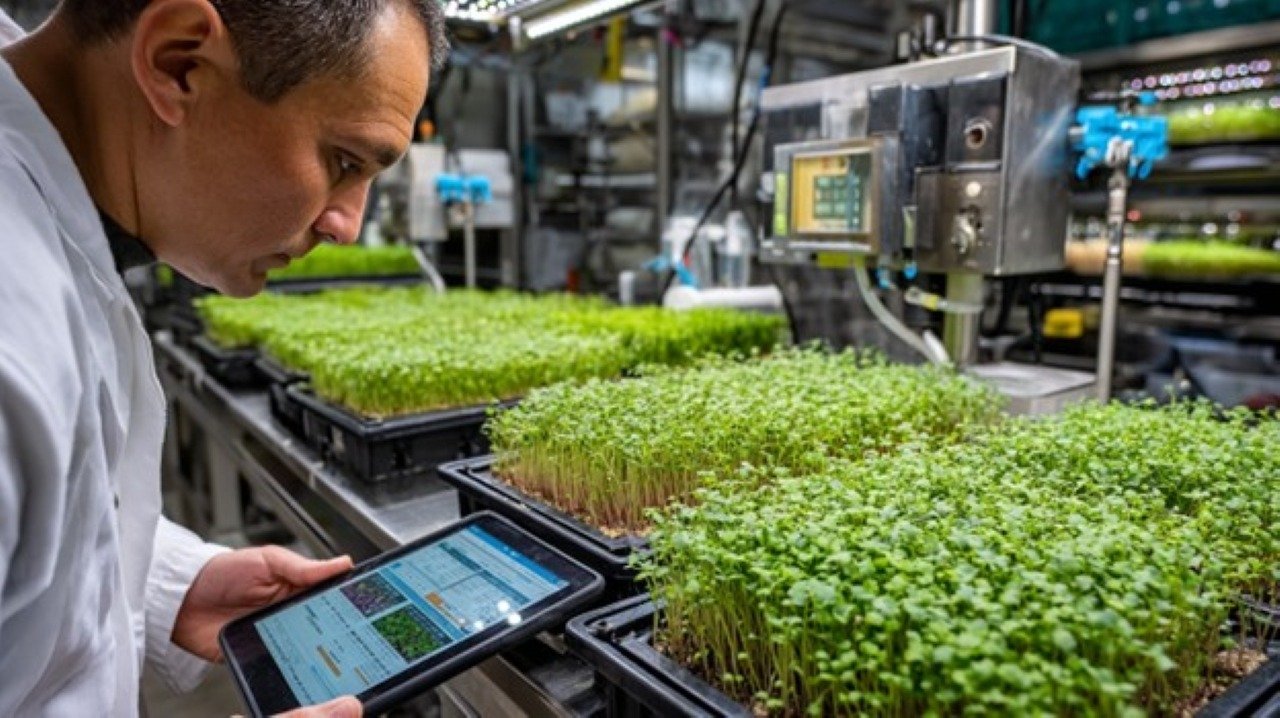
While your initial costs get you started, your ongoing expenses will determine your long-term profitability in the microgreens business.
You’ll need to budget regularly for seeds (typically your largest recurring cost), growing medium, and utilities like electricity for your grow lights and water for irrigation.
Don’t forget to factor in packaging materials—those clear plastic clamshells or compostable containers aren’t free, and their costs can add up quickly as your operation scales.
Seeds (your biggest ongoing expense)
Despite their small size, seeds represent the largest recurring expense you’ll face in your microgreens operation.
Your seed sourcing options range from local garden centers (convenient but pricier) to bulk agricultural suppliers—where you’ll find significant savings when purchasing by the pound. Seed quality impacts everything from germination rates to flavor profiles, so don’t automatically choose the cheapest option; instead, invest in certified organic varieties when possible.
Proper seed storage tips can extend your inventory’s viability while reducing waste. Store seeds in airtight containers in cool, dark locations—refrigeration works well for most varieties.
You’ll want to organize your inventory meticulously (labeled with purchase dates), as even high-quality seeds lose germination potential over time.
Remember: the seed selection process is where your microgreens business truly begins—choose wisely!
Growing medium
The growing medium represents your microgreens’ foundation—literally and financially. While not as expensive as seeds, you’ll need a consistent supply of high-quality medium that balances cost with performance.
Most growers choose between soil types (organic potting mix), coco coir, or soilless blends—each with different price points and nutrient balance properties.
You’ll spend approximately $15-25 monthly for every 20 trays in production, depending on your chosen medium. Smart growers often buy in bulk to reduce costs, but keep in mind that storage space becomes another consideration.
Proper moisture control also factors into your medium expenses—inefficient watering can lead to waste or disease, requiring replacement. Some commercial growers reduce costs by creating custom blends, combining peat moss, vermiculite, and compost to achieve optimal growing conditions while maintaining their profit margins.
Electricity (especially for lights)
Electricity costs represent a significant ongoing expense that many new microgreens growers underestimate when calculating their operational budget. Your grow lights typically run 12-16 hours daily, which adds up quickly on your utility bill.
To manage these lighting costs, you’ll want to investigate energy efficient options like LED fixtures, which consume 50% less electricity than fluorescent alternatives while providing better spectral output for plant growth.
Consider implementing electricity conservation practices by utilizing timers to streamline lighting schedules, arranging your growing racks to maximize light coverage, and taking advantage of natural light when possible.
Smart power strips can also help eliminate phantom energy consumption during off-hours. Remember, every kilowatt saved directly improves your bottom line—the difference between running standard fixtures versus energy-efficient LEDs could mean hundreds of dollars annually in a modest growing operation.
Water
Water usage forms another line item in your operational budget that requires careful monitoring and management.
While microgreens don’t guzzle water like conventional crops, you’ll still need to implement effective water management strategies to maintain ideal growing conditions and control costs.
Consider investing in simple irrigation systems that deliver consistent moisture—from basic spray bottles for small operations to mechanized misting systems as you scale up.
You’ll find that moisture control techniques, such as bottom watering or capillary mats, can reduce your water consumption while promoting healthier plants (and preventing costly crop losses from mold or disease).
Packaging materials
When selling microgreens commercially, packaging becomes a significant ongoing expense that you’ll need to factor into your operational budget.
Most growers utilize clear clamshell containers (4-8 oz) or compostable alternatives that showcase the vibrant colors of your product while protecting delicate greens during transport.
You’ll want to examine sustainable packaging options — like plant-based containers or recycled plastic — which might cost more initially but can strengthen your branding strategies with eco-conscious customers.
Don’t overlook the importance of attractive labels (with your logo, growing methods, and harvest date) that help build recognition at farmers’ markets and during effective distribution to restaurants.
Delivery costs
Beyond packaging your microgreens in attractive containers, you’ll need to get your product into customers’ hands—and that means confronting transportation expenses. Your delivery logistics will quickly become a significant line item in your weekly budget, especially as you expand beyond local farmers’ markets.
Smart cost management involves mapping efficient routes (delivering to restaurants during non-peak hours), batching deliveries by neighborhood, and potentially implementing minimum order requirements to guarantee transportation efficiency.
You’ll need to calculate the real costs—fuel, vehicle maintenance, insurance, and your time—and factor them into your pricing structure. Many successful growers charge delivery fees for orders below a certain threshold or offer discounts for customer pickup.
Bear in mind that reliable delivery becomes part of your brand’s value proposition—customers will pay premium prices when they know your microgreens will arrive precisely when promised.
Marketing
Many new microgreens growers underestimate the consistent marketing investment required to build and maintain a profitable business. Your gorgeous trays of vibrant greens won’t sell themselves—you need to budget for ongoing promotion efforts that connect your product with your target audience.
| Marketing Element | Monthly Cost | Value | Implementation Tips |
| Social media strategies | $50-150 | Brand awareness | Post twice weekly with harvest photos |
| Printed materials | $30-75 | Local recognition | Design professional business cards and brochures |
| Website maintenance | $20-40 | Digital presence | Update inventory and blog regularly |
| Community events | $100-300 | Direct customer contact | Sample tables at farmers markets, food events |
Remember that branding essentials—like your logo, packaging design, and photography—create the first impression for potential customers. These aren’t just expenses; they’re investments that position your microgreens as premium products worth premium prices.
Licenses and permits renewal
The paperwork parade of licenses and permits doesn’t end once you’ve launched your microgreens business—these legal requirements follow you throughout your entrepreneurial journey.
You’ll need to track renewal frequency for various licenses types, which typically range from annual to triennial depending on your location and operation size.
Most food production permits require yearly renewal, while business licenses might extend to 2-3 years.
Don’t wait until the last minute; many permit applications require updated documentation, proof of continued compliance, and sometimes additional inspections.
Consider creating a digital calendar with 30-day advance notifications for each renewal deadline.
The cost varies widely by region—from $50 for simple business license renewals to several hundred dollars for specialized food production permits—so factor these recurring expenses into your annual budget to avoid unwelcome surprises.
Are You Ready to Start Your
Microgreens Business?
Take a 5-minute assessment and discover your strengths and gaps
before you invest
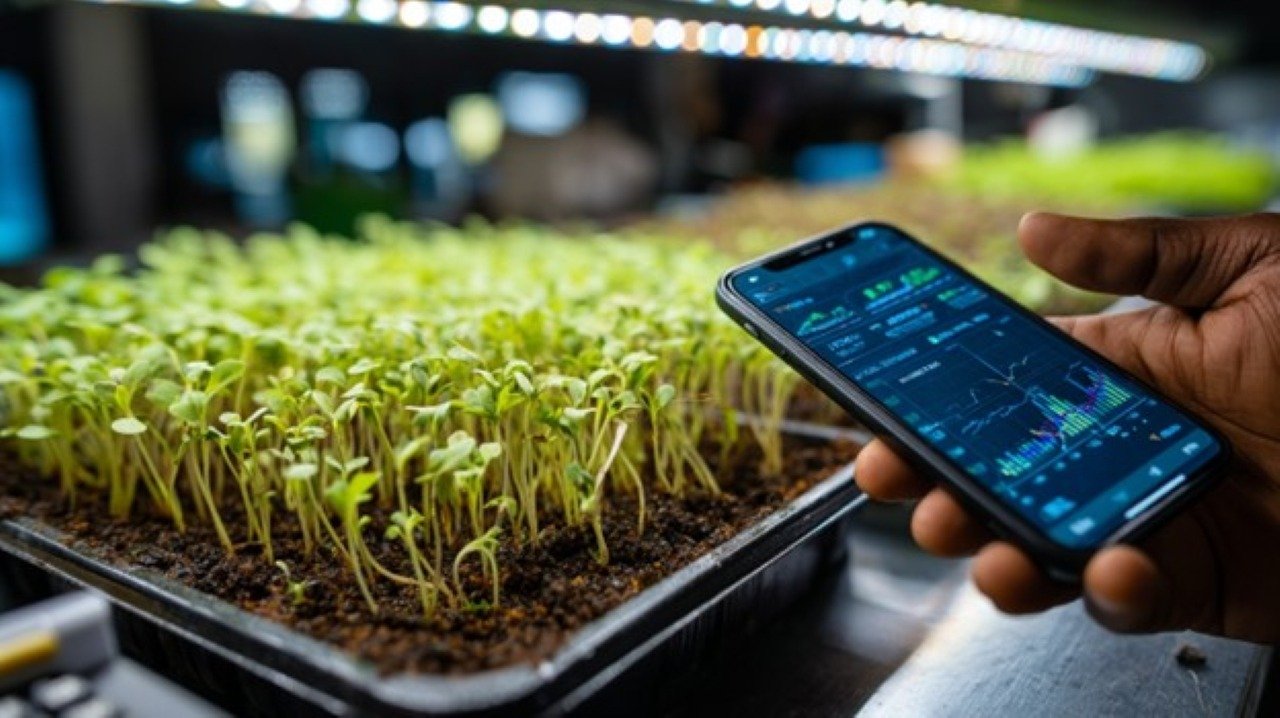
Before launching your microgreens business, you’ll need to invest time in market research to understand potential customers and competitors.
You can gather valuable insights by visiting local restaurants and grocery stores to discuss their interest in microgreens, while also purchasing competitors’ products to analyze their quality, pricing, and packaging.
Testing different microgreen varieties will help you determine which ones perform best in your growing environment and which might appeal most to your target market.
Visiting potential customers like restaurants and grocery stores
Visiting potential restaurant and grocery store customers requires more than just showing up with sample microgreens in hand. You’ll need a strategic approach that considers timing, presentation, and value proposition. Chefs and produce buyers are busy people—catching them during slow periods (typically 2-4 PM) will increase your chances of meaningful customer feedback.
| Customer Type | What They Value | Pricing Strategies |
| Fine Dining | Unique varieties, consistency | Premium pricing, farm partnerships |
| Casual Restaurants | Reliability, common varieties | Volume discounts |
| Grocery Stores | Shelf life, packaging | Wholesale pricing |
| Farmers Markets | Story, local connection | Direct-to-consumer markup |
When presenting samples, bring them in the same packaging you’ll employ for delivery—this shows professionalism and helps buyers visualize your product in their operation. Listen carefully to their needs rather than just pitching your greens.
Sampling competitor products
Understanding your competition forms another pillar of thorough market research, complementing your customer visits.
You’ll need to purchase and analyze microgreens from other local producers to gain strategic insights into what you’re up against.
Examine competitor pricing across different varieties—note which commands premium rates and which sell at volume discounts.
Pay attention to product variety; are they focusing on rare, exotic microgreens or sticking to reliable staples like sunflower and pea shoots? Their choices reveal market gaps you might fill.
Study their market positioning carefully—do they present themselves as luxury ingredients for high-end restaurants or affordable health foods for everyday consumers?
Their packaging, branding, and delivery methods tell a story about their business model that you can learn from—or strategically differentiate yourself against.
This competitive intelligence is worth every penny invested.
Testing different varieties
Testing different microgreen varieties constitutes an essential—yet often overlooked—component of your market research investment.
Don’t just grow what you personally enjoy; instead, implement strategic variety selection strategies based on comprehensive taste profile comparisons and market demand analysis.
You’ll need to dedicate time and resources to growing small batches of diverse microgreens—from spicy radish to nutty sunflower—to determine which perform best in your specific growing environment.
Compare germination rates, growth speeds, and yield potential while simultaneously evaluating market receptiveness. What sells quickly at your farmers’ market might differ dramatically from what local restaurants crave.
Think of this testing phase as your business’s R&D department—a small investment now that prevents costly inventory mistakes later.
The most successful growers continually test new varieties, modifying their offerings to meet evolving customer preferences.
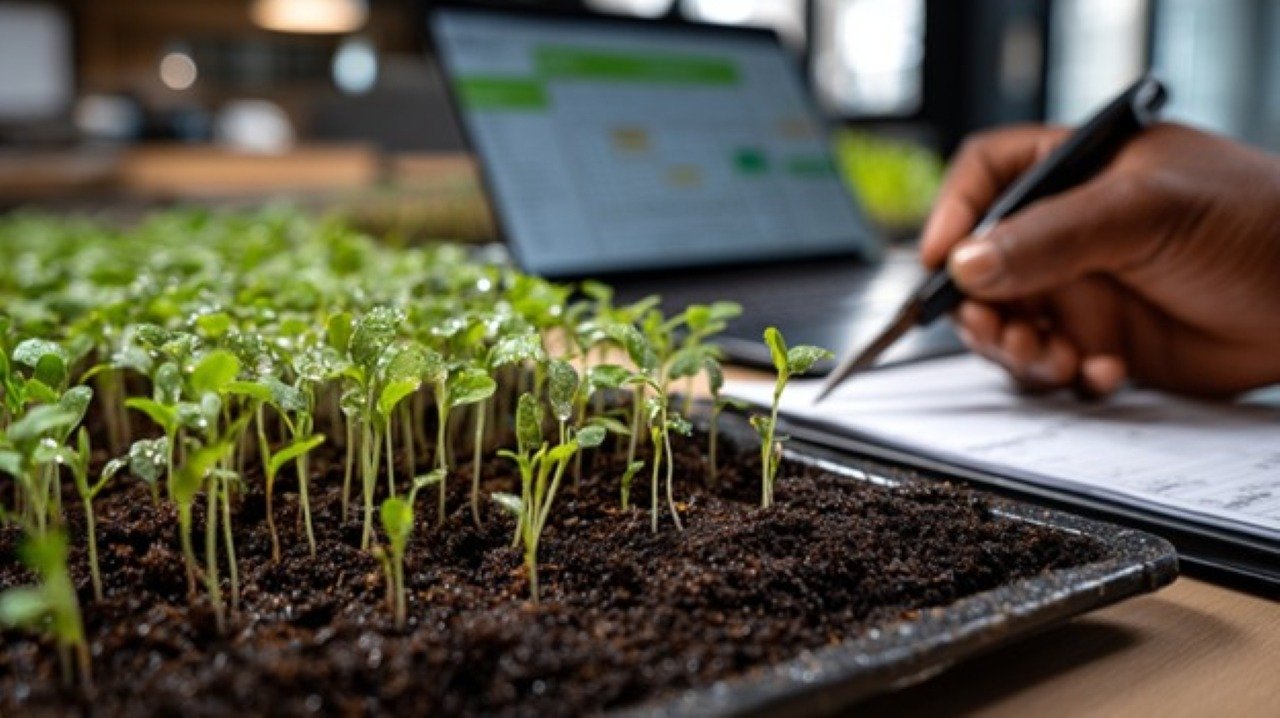
You don’t need to break the bank to launch your microgreens business—smart cost management can keep startup expenses exceptionally low.
Begin with just a few trays in a spare room or basement, focusing your investment on quality grow lights and seeds while finding creative DIY solutions for shelving and packaging.
As you excel at growing high-value varieties that command premium prices (like sunflower and pea shoots), you’ll create the perfect foundation for scaling up when customer demand justifies the expansion.
Start Small and Grow
Most successful microgreens entrepreneurs begin with just a handful of trays rather than investing in an elaborate setup from day one. This approach allows you to refine growing techniques for profitable microgreens varieties like sunflower and pea shoots while minimizing financial risk.
You’ll learn which crops thrive in your specific environment—whether that’s a basement, spare bedroom, or urban farming setup.
Start with 5-10 trays focused on 2-3 varieties that align with healthy eating trends in your market. As demand increases and you perfect your growing system, reinvest profits into additional shelving, better lighting, and expanded seed inventory.
Buy Quality Where It Matters
Every dollar counts when launching a microgreens business, but certain investments simply shouldn’t be compromised. When allocating your startup funds, prioritize quality materials for the elements that directly impact your yield and efficiency.
Your grow lights deserve premium investment—efficient LEDs will save you hundreds in electricity costs over time while providing consistent spectrum coverage that cheap alternatives can’t match.
Sturdy shelving (capable of holding water-laden trays without sagging) is another essential equipment area where cutting corners leads to costly disasters.
Finally, don’t skimp on seeds—premium varieties from reputable suppliers deliver superior germination rates and consistent growth patterns, maximizing your cost efficiency per tray.
Not all equipment needs to be top-of-the-line
When starting your microgreens business, you’ll need to be strategic about where you invest your limited funds.
While you shouldn’t cut corners on grow lights (their energy efficiency will save you money long-term), sturdy shelving (that safely supports your growing trays), and quality seeds (which directly impact your yield and profit), many other items can be purchased second-hand or DIY’d.
You can gradually upgrade your equipment as your business grows, allowing you to prioritize these three critical areas where quality truly affects your bottom line.
Grow lights (energy efficiency pays off)
Although you might be tempted to purchase the cheapest grow lights available, investing in energy-efficient LED grow lights will significantly reduce your electric bills over time—often paying for themselves within the first year of operation.
LED advantages include longer lifespans (up to 50,000 hours), lower heat output, and customizable light spectrums that maximize plant growth. Among grow light types, LEDs deliver the most substantial energy savings—typically 40-60% less electricity than fluorescents.
Shelving (must support weight safely)
| Shelving Material | Cost | Weight Capacity | Durability |
| Wire metro racks | $$$ | Excellent | High |
| Steel bookcases | $$ | Good | Medium |
| Wood DIY shelves | $ | Varies | Low-Medium |
| Plastic units | $ | Poor | Low |
Seeds (quality affects yield)
Three essential factors make seed quality your most important investment in a microgreens operation.
First, superior genetics guarantee robust germination rates—saving you money on seed sourcing strategies.
Second, disease-resistant varieties reduce crop failures during vital growing phases.
Third, proper seed storage solutions (cool, dry environments) extend viability, meaning you’ll waste less inventory while maximizing each tray’s yield potential.
DIY When Possible
Smart DIY solutions can dramatically slash your microgreens startup costs while teaching you valuable skills that benefit your business long-term.
By building your own growing racks from PVC pipes or repurposed shelving units, you’ll save hundreds compared to commercial alternatives—money better invested in quality seeds or lighting.
Creative solutions abound for resourceful growers: design your own drainage systems using plastic trays and mesh screens, mix custom soil blends tailored to specific microgreen varieties, or construct simple humidity domes from recycled materials.
When you’re starting out, these DIY techniques provide substantial cost savings while giving you deeper insight into your operation’s needs.
Focus on High-Value Microgreens
Beyond building your own equipment, selecting the right crops for cultivation can make a significant difference to your bottom line. Not all microgreens deliver equal returns—sunflower, pea shoots, and radish typically command premium prices while requiring similar growing efforts as their less profitable cousins.
When choosing high value varieties, consider both market demand and your growing conditions—what thrives in your setup will fundamentally generate better profits.
Your marketing strategies should emphasize the nutritional density of these premium crops (remember, they contain up to 40 times more nutrients than mature plants). Develop tiered pricing approaches based on exclusivity—restaurants might pay more for specialty varieties they can’t source elsewhere.
Consider a “premium mix” that combines visually striking options like purple kohlrabi with flavor-packed favorites like basil—customers will pay extra for both beauty and taste.

You’ll enjoy one of the best advantages of microgreens when you start seeing cash flow within just two weeks of planting.
Your quick turnaround from seed to harvest (7-14 days for most varieties) means you’re not waiting months to see returns on your investment.
This rapid cycle allows you to adjust your growing strategy based on what’s selling best, giving you flexibility that traditional farming simply can’t match.
The fast growth cycle means quick cash flow
The cash register rings faster with microgreens than almost any other agricultural product. While traditional crops might keep your capital tied up for months, microgreens deliver returns in just 7-14 days. By perfecting fast turnover techniques and optimizing crop selection, you’ll create a business with weekly income potential.
| Microgreen Variety | Days to Harvest | Profit Per Tray |
| Radish | 7-10 days | $15-20 |
| Sunflower | 8-12 days | $18-25 |
| Pea Shoots | 10-14 days | $20-30 |
| Broccoli | 10-12 days | $18-24 |
Maximizing harvest efficiency means you’ll plant Monday, harvest the following week, and immediately replant that space. You’re essentially creating a continuous production line—while this week’s crop grows, last week’s harvest is already generating income.
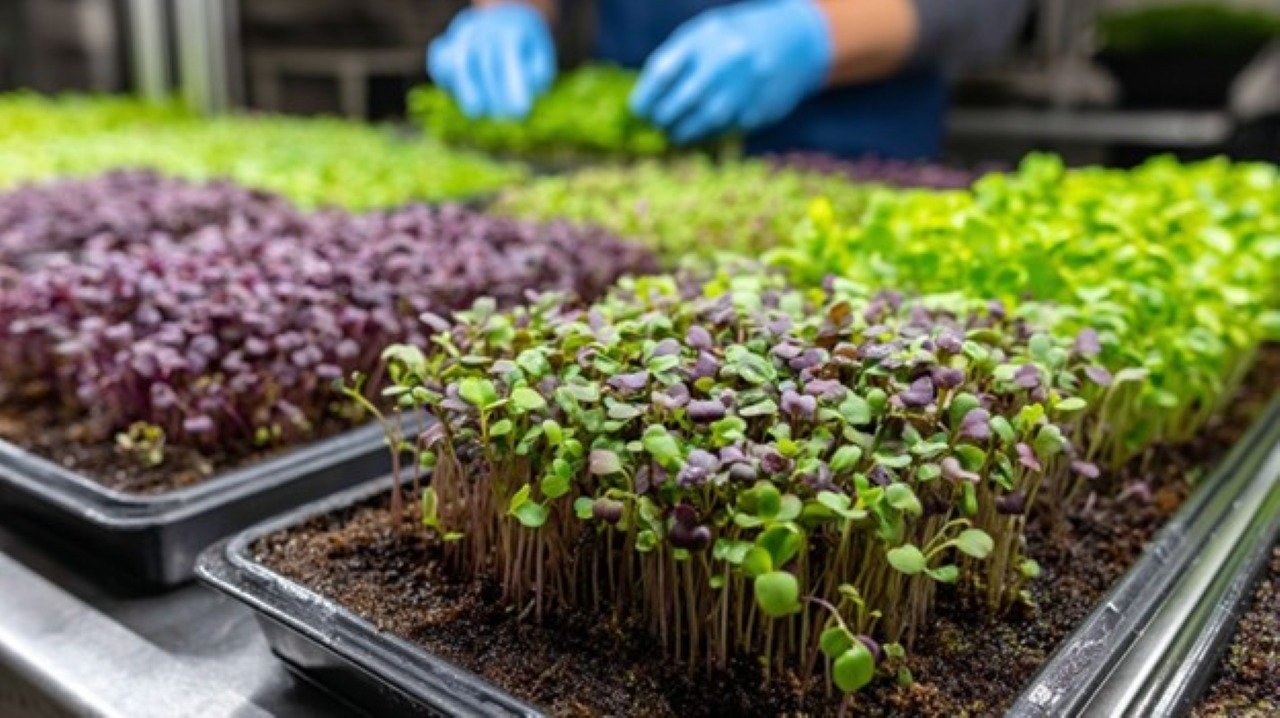
Why do some microgreens entrepreneurs thrive while others quickly wither?
Success hinges on more than just technical know-how—it requires genuine passion for what you’re growing. You’ll need to stay current with microgreens market trends while developing strong local customer engagement strategies.
Those who adopt sustainable farming practices often connect more deeply with today’s health-conscious consumers.
You’re likely a good fit if you genuinely enjoy nurturing plants, have patience for detailed work, and feel motivated by providing nutritious food to your community.
The daily reality involves early mornings, consistent attention to growing conditions, and building relationships with chefs and market customers.
Consider this: if the thought of monitoring seedling progress excites you more than exhausts you, you’ve found your calling.
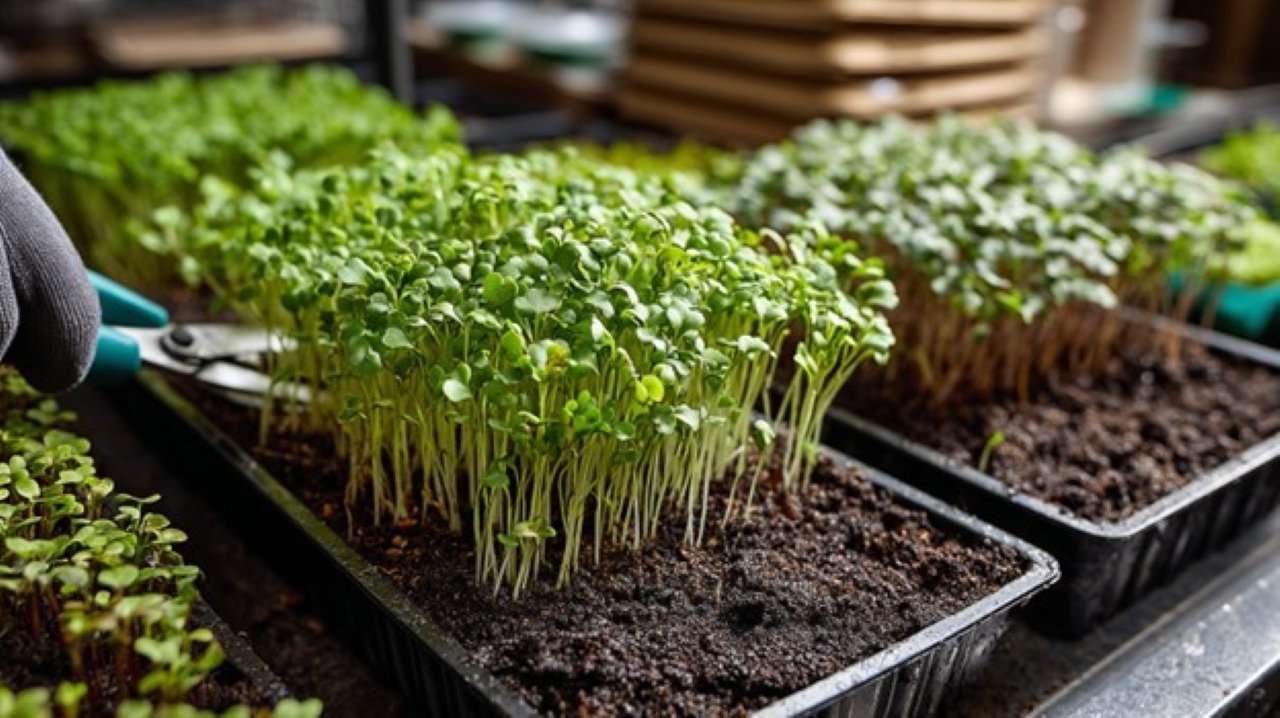
You’ll want to begin your microgreens journey by growing a few test trays at home, researching your local market, and creating a straightforward business plan.
Next, focus on perfecting just 3-5 varieties before expanding your selection—sunflower, pea shoots, and radish microgreens are excellent starter crops with reliable germination rates.
Once you’ve honed your growing technique and identified your market, set up a dedicated growing space with proper shelving, lighting, and ventilation to guarantee consistent, high-quality harvests.
Start growing at home to practice
Before investing a single dollar in trays, seeds, or lighting systems, dedicate at least a month to growing microgreens in your kitchen or windowsill as a trial run. This home growing period offers invaluable benefits, allowing you to develop essential skills without financial pressure.
You’ll uncover which varieties thrive under your care—start with resilient options like sunflower, pea shoots, and radish for early success.
Indoor gardening tips that’ll save you heartache later: monitor moisture levels carefully (damp but never soggy); maintain consistent light cycles (16 hours on, 8 off); and ventilate properly to prevent mold.
The seed selection strategies you develop now will translate directly to commercial production—observe germination rates, growth speeds, and flavor profiles.
Think of this phase as your microgreens internship—the lessons you’ll learn are worth far more than the minimal costs involved.
Research your local market potential
Understanding local market dynamics remains the cornerstone of any successful microgreens venture, regardless of how perfect your sunflower shoots might look.
Before sinking money into trays and seeds, invest time scouting potential local customers—restaurants, farmers’ markets, health food stores, and CSA programs often become your bread-and-butter clients.
Don’t just rely on hunches; perform a thorough competitive analysis by visiting farmers’ markets to see who’s already selling microgreens (and what they’re charging).
You’ll quickly identify whether your area is underserved or saturated.
Test various marketing strategies by offering free samples to chefs—their feedback is worth its weight in gold!
Create a simple business plan
A solid business plan serves as your microgreens operation’s roadmap, even if it’s just a few pages long. Your plan should clearly outline your business goals—whether that’s supplying five restaurants weekly or reaching $2,000 in monthly sales within six months.
Identify your target market with precision. Are you selling to chefs, farmers markets, or health-conscious consumers? Each requires different approaches.
Develop a pricing strategy that reflects both market realities and your costs—most successful growers charge $25-50 per pound, maintaining healthy margins while remaining competitive.
Choose 3-5 varieties to master first
While many aspiring growers feel tempted to start with dozens of seed varieties, you’ll build stronger foundations by perfecting just 3-5 microgreen types initially.
Consider these variety selection tips: start with forgiving, fast-growing options like sunflower, pea shoots, and radish—each thrives in slightly different optimal growing conditions but won’t punish minor mistakes.
Pay attention to customer preferences in your area; restaurants often seek colorful varieties like red amaranth or purple kohlrabi, while farmers’ markets favor familiar flavors like broccoli or basil.
You’ll develop essential skills (proper seeding density, watering techniques, harvest timing) that transfer across varieties without the overwhelm of managing too many crops simultaneously.
Think of it like learning to drive—master one vehicle before attempting a motorcycle, truck, and sports car all at once!
Set up your growing space
Three essential components form the foundation of your microgreens growing space: proper shelving, adequate lighting, and consistent climate control.
Your shelves should be sturdy enough to hold water-laden trays (each can weigh 5-10 pounds) while maximizing vertical space—think industrial wire racks rather than decorative bookcases.
For lighting, LED grow lights provide the perfect spectrum while keeping electricity costs manageable. Position them 12-18 inches above your trays to prevent leggy growth.
Temperature (60-75°F) and humidity (50-60%) monitoring will enhance your growing techniques and guarantee consistent harvests.
Don’t overlook ergonomics—you’ll be working here daily. Arrange your packaging solutions (scales, bags, labels) in a dedicated area, keeping your workflow efficient.
Get necessary permits and licenses
Legal compliance forms the bedrock of your microgreens business, preventing costly penalties and potential shutdowns before you’ve even harvested your first tray.
Start with a comprehensive legal requirements overview by contacting your local Small Business Administration office—they’ll guide you through specific regulations in your area.
The permit application process typically includes business registration, food handler’s permits, and possibly zoning approvals if you’re growing from home.
Don’t overlook cottage food laws, which vary dramatically by state but often provide simplified pathways for small-scale producers.
Mark your calendar with license renewal tips: set digital reminders 60 days before expiration dates, maintain digital copies of all documentation, and budget annually for renewal fees—they’re predictable expenses you can plan for (unlike that unexpected pH imbalance in last week’s sunflower batch).
Start building relationships with potential customers
Before your microgreens even sprout their first true leaves, you’ll need to foster something just as vital—customer relationships. Building Trust begins with quality samples that showcase your best varieties, allowing potential clients to experience your product firsthand.
Customer Engagement Strategies should include tailored follow-ups—a quick text asking how the chef liked those sunflower shoots can work wonders.
Don’t underestimate the power of consistency in delivery and quality; restaurants and retailers value reliability above all else.
Take advantage of Networking Events like farmers’ markets, food festivals, and chef associations to expand your reach.
These gatherings aren’t just selling opportunities—they’re research labs where you’ll ascertain what varieties customers crave most.
How Do I Handle Pests Without Chemicals?
You’ll find success with natural pest control by introducing beneficial insects like ladybugs that eat aphids, implementing companion planting strategies, and maintaining proper airflow between your trays to prevent mold and pests.
Can I Grow Microgreens Organically?
Yes, you can grow microgreens organically! Focus on using organic growing techniques, maintaining excellent soil health, and selecting untreated seeds. You’ll produce healthier greens that command premium prices in the marketplace.
What’s the Shelf Life After Harvest?
Your microgreens typically have a 5-7 day shelf life after harvest. You’ll maximize storage by using proper harvesting techniques—cutting cleanly when mature. Refrigerate immediately in breathable containers to maintain nutrient retention and freshness.
Which Varieties Have the Highest Profit Margins?
You’ll find the highest profit margins in high demand varieties like sunflower, pea shoots, and broccoli microgreens. These thrive in simple growing conditions while commanding premium market pricing due to their flavor and nutritional value.
How Do I Prevent Mold During Cultivation?
To prevent mold, guarantee proper ventilation around your trays and control humidity (keep it below 50%). Don’t overwater your microgreens, provide adequate airflow with fans, and sanitize your equipment regularly. Space trays appropriately for air circulation.
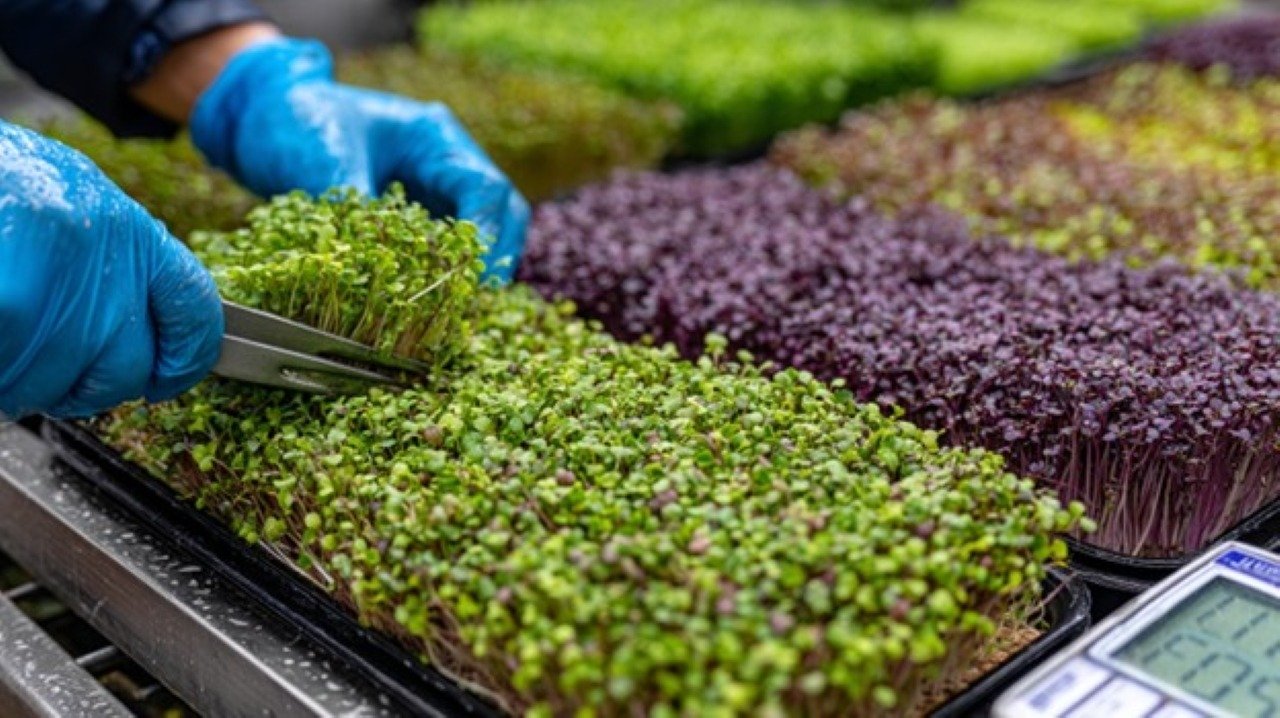
When you consider all the numbers and opportunities we’ve examined, starting a microgreens business emerges as one of the most accessible paths to agricultural entrepreneurship available today.
With minimal space requirements and startup costs as low as $500, you’re not just growing plants—you’re cultivating a sustainable business model that aligns with growing consumer interest in microgreens sustainability, culinary applications, and health benefits.
You don’t need a farming background or acres of land—just determination, attention to detail, and willingness to learn.
The fast growth cycles mean you’ll quickly see if this business suits you, without years of waiting for returns.
Whether you’re seeking extra income or a complete career change, microgreens offer a practical entry point into the food production industry with astonishingly low barriers to entry.
Are You Ready to Start Your
Microgreens Business?
Take a 5-minute assessment and discover your strengths and gaps
before you invest
